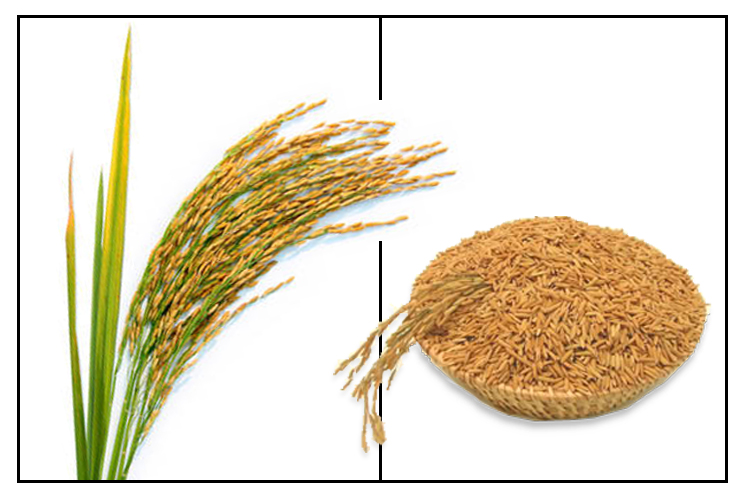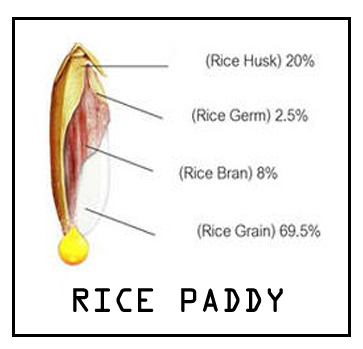 General
info General
info
Darak was first used in the
early 1900s for "taon," a disease afflicting children,
successfully treated with daily doses of a sweetened decoction
of dry roasted darak. The affliction was later identified as "beriberi."
Twenty years later, Manuel Zamora, a pharmacist, developed a
darak extract in syrup form, bottling it as "Tiki-tiki."
 Rice is grown in over 100 countries, and with over 18,000 varieties it accounts for about 25% of the world's grain production. (7) Rice is grown in over 100 countries, and with over 18,000 varieties it accounts for about 25% of the world's grain production. (7)
Rice bran is the by-product of the rice milling process. It is the hard outer layer between the inner white rice grain and the outer hull (husk).
Milling of the paddy yields 70% rice (endosperm) as the major product, with by-products of 20% rice husk, 8% rice bran and 2% rice germ. (7)
Rice bran (which includes the germ) accounts for 60% of the nutrients found in each rice kernel.
Constituents
- Each 100 kg of paddy rice will yield about 5 to 10 kg of bran.
-
Contains vitamins A, B complex,
D and E; fat, 20%; carbohydrates; proteins; adenine; choline;
arachidic, behenic, lignoceric, palmitic, and oleic acids; phytosterin.
- Rice bran along with the germ yields phytonutrients like oryzanols, tocopherols, tocotrienols, phytosterols, 20% oil and 15% protein, 50% carbohydrate (mostly starch) dietary fibers like beta-glucan, pectin, and gum[3,8- 10].
(7)
- Yields a rice bran oil rich in vitamin E tocopherol and tocotrienol. It has a saturated fatty acid to good monosaturated fatty acid ratio of <10:10-15.
- The higher oryzanol levels in RBO may contribute to the higher FFA values in this oil.
(13)
- RBO content of linoleic acid is moderate among the vegetable oils (-40% of total fatty acids), but still a rich source. It also contains relatively high proportion of oleic acid (40%). There is detectable amounts of α-linolenic acid (1 to 3%), which may be enough to increase the content of (n-3) highly polyunsaturated fatty acids such as eicosapentaenoic and docosahexaenoic acids in tissue phospholipids. The remaining major fatty acid in RBO is palmitic acid, 17%.
(6)
- Rice bran oil refining industry produces residues such as wax sludge, gum sludge and soap stock that are a rich source of many neutraceuticals like oryzanols, tocopherols, tocotrienols, ferulic acid, phytic acid, lecithin, inositol and wax. (7)
Properties
- Rice bran oil is low in saturated fat. 100 kg of paddy rice will yield about 5 to 10 kg of bran.
- Rancidity of rice bran has hampered complete exploitation of potential use and application for cholesterol reduction, combating cancer, alleviating menopausal and postmenopausal symptoms
Uses
Edibility
· Used as food supplement or additive.
· Rice bran yields an edible oil.
Folkloric
· Beriberi
and other vitamin deficiencies: 25% tea decoction. The bran can
also be made into cookies or mixed with other bakery products.
· Laxative: Two teaspoons of Darak in one glass of water;
cool, stir well and drink, daily as needed.
Others
· Fringe
folkloric: Pillows
stuffed with darak has been used as a sleep aid for insomniacs.
· Animal Feed: Earlier, used primarily as animal feed.
· Wax: Rice bran wax (RBW) is a by-product of the dewaxing step of the refining process, with potential applications in pharmaceutical, food, cosmetic, polymer and leather industries. (7)
· PHA: Poly hydroxy alkanoates (PHA) are environment-friendly analogues of pterochemical derived plastics, with potential applications in the manufacture of paper, cardboard, food trays, controlled drug release, sutures, paramedical disposables and therapeutic devices. (7)
Studies
• Rice Bran Oil / Hypocholesterolemic: Study assessed the effects of defatted rice bran and rice bran oil in an average American diet on blood lipids in moderately hypercholesterolemic persons. Defatted rice bran diet did not lower lipid concentrations. However, total cholesterol was significantly lower with diet containing rice bran oil; also, the LDL was lower, while HDL remained unchanged. Study concludes that rice bran oil, not fiber, lowers cholesterol in healthy, moderately hypercholesterolemic adults, and that the reduction in cholesterol was due to other components in the rice bran oil, such as unsaponifiable compounds. (1)
• Phytic Acid: Study investigated methods for improved extraction and purification of PA (phytic acid) with high purity and yields. Phytic acid, once considered an anti-nutritional compound, has become known for its beneficial effects on human health (diabetes, renal calculi, Parkinson's disease, and cancer). (2)
• Benefits of Stabilized Rice Bran on Glucose and Lipid Parameters in T2DM: Stabilized rice bran (SRB), a source of complex carbohydrates, tocols, a-oryzanols, and polyphenols, treated with carbohydrates and heat yielded RBWS (rice bran water solubles) and RBFC (rice bran fiber concentrates. SRB and its fractions were fed to insulin dependent and non-insulin dependent diabetic subjects. Results showed RBWS significant reduced hyperglycemia, while RBFC reduced hyperlipidemia in both types of diabetes. (3)
• Cooking with a Blend of Sesame and Rice Bran Oil: Study presented at the American Heart Association's High Blood Pressure Research 2012 Scientific Sessions suggested that people who cooked with a blend of sesame and rice bran oil saw significant drop in blood pressure and improved cholesterol levels. The decrease in BP was nearly as well as prescribed high blood pressure medications, and the use of the oil blend with medication yielded even more impressive results. (5)
• Hypocholesterolemic / RBO and Safflower Oil Blend: Study observes the blending of rice bran oil and safflower oil at definite proportion (7:3 wt/wt) magnifies the hypocholesterolemic efficacy, compared to the effect of each alone. The presence of peculiar components such as gamma-oryzanol and tocotrienols could be responsible for the hypocholesterolemic effect of RBO. (6)
• Rice Bran as Food Additive / Dietary Fiber / Laxative / Decreased Colon Risks: Its major use as additive is due to its dietary fibers conferring a good laxative property. Studies have also shown that the intake of dietary fiver was inversely related to the occurrence of colorectal cancer.
• Decreased Atherosclerotic Plaque and Antioxidative Effects: Study reported the influence of supplementation of black and white rice outer layer fractions on atherosclerotic plaque formation induced by hypercholesterolemia in male rabbits. The inhibition of atherosclerotic plaque formation from black rice outer layer fraction might be mediated by antioxidative or anti-inflammatory effects. (8)
• Anti-Ageing Components: Oryzanol component acts as a protective agent against UV light induced lipid peroxidation with potential use as sunscreen plant. Ferulic acid and its esters in gamma oryzanol stimulated hair growth and prevents skin ageing. (7)
• Long-Term Storage Effect / Refined and Crude RBO: Stability of tocopherols and tocotrienols in crude oil was completely different from that in refined oil. Compared to tocopherols, sterols showed a better stability during the entire storage period. The exposure to daylight heavily affected the composition and the stability of both crude and refined rice bran oil. (9)
• Long-Term Storage Effect / Refined and Crude RBO: A PGIMER study in India showed the oryzanol present in rice bran oil had better cholesterol lowering properties, decreasing total cholesterol, LDL cholesterol and triglyceride levels when compared to olive oil and ground nut oil in a randomized, open labelled study even without diet restriction and physical activity instructions issued. (10)
• y-Oryzanol / UV Protection: Along with lecithin, tocopherols and tocotrinols, y-oryzanol is one of the waste products of rice brane during the refining process. It is a mixture of ferulic acid esters of sterol and triterpene alcohols, occurring in rice bran oil at 1-2% serving as antioxidant. It has a protective role in UV-light induced lipid peroxidation, hence it is used as sunscreen agent. Ferulic acid and its esters stimulate hair growth and prevent skin aging. (11)
• γ-Oryzanol / Effects on Menopause: Two uncontrolled studies investigated the use of γ-oryzanol for menopause. A Japanese study reported it halved menopausal symptoms such as hot flushes in 67% of women. A later Japanese study on perimenopausal women receiving 300 mg of γ-oryzanol daily reported 90% improvement in women with 40% experiencing "excellent effectiveness." (11)
• Safety for Human Consumption: Toxicological studies of RBO by the food safety evaluation protocol of WHO/FDA/DGHS were carried out in rats for three generations. The reproductive performance was comparable to GNO-fed animals. The results indicated that there were no abnormalities in any of the parameters studied, indicating the safety of RBO for human consumption. (12)
Availability
- Commercially available as animal feed. |


![]()

